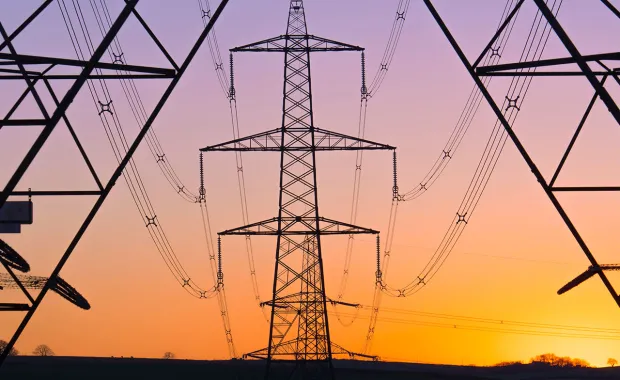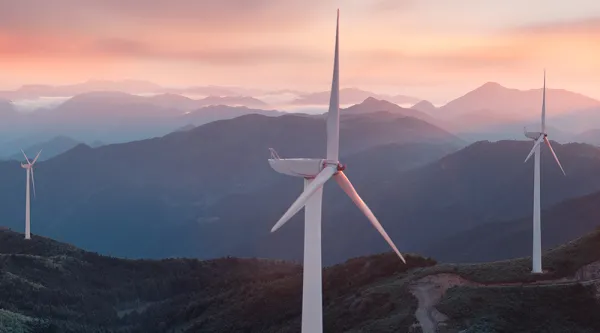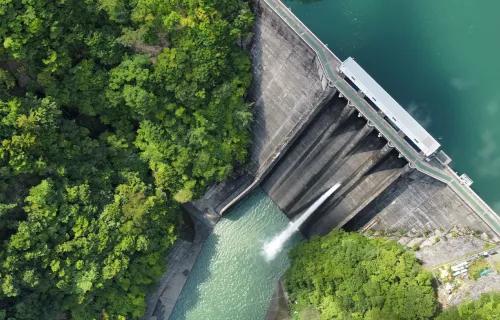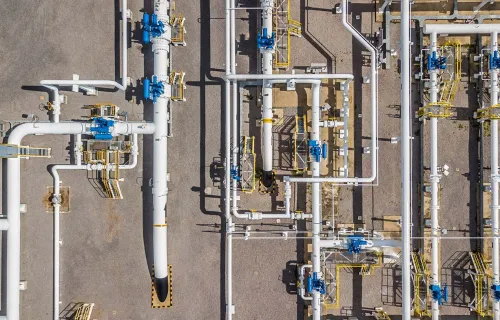In this first of two episodes for our Energy Transition Talks series, Eurelectric’s Head of Energy Policy, Climate and Sustainability Paul Wilczek joins Peter Warren to examine the intrinsic link between decarbonization and electrification, plus the consequent opportunities shaping the energy landscape. They discuss the need for grid investment and modernization, how transparent information helps bridge gaps between governments and public opinion, upfront costs versus long-term benefits of electrification and how reforming energy taxation and billing can shape the future of electrified communities.
Decarbonization and electrification: A pivotal shift
By 2040, Europe aims to have a largely decarbonized power sector, paving the way for the widespread adoption of electrification across various sectors. According to Paul, this transition not only promotes energy efficiency but also offers significant environmental benefits. As he shares, electrified systems, such as heat pumps for residential heating, can use “just two-thirds of the primary energy” required by traditional gas-based heating systems, resulting in substantial energy savings. Peter indicates that a shift is happening in North America as well, citing the current U.S. government’s incentives for heat pumps.
Despite the increasing adoption of electric vehicles (EVs), heat pumps and other electrified technologies, the overall electrification rate in Europe remains stagnant at around 22-23%. This is surprising, Paul point says, as the growing number of electrified processes and users would indicate the rate would rise.
The primary focus has been on decarbonizing the power sector, with efforts to transition to renewable and clean energy sources. However, Paul reveals, the remaining 78% of energy consumption across other sectors has been largely overlooked. Electrification presents an effective solution for further decarbonization, as the electricity grid becomes increasingly green and decarbonized.
According to projections from the European Commission, electrification is expected to account for 35% of final energy demand by 2030, rising to 50% by 2040, and potentially reaching 60-70% by 2050.
The transformation of transportation
The transport sector is undergoing a profound transformation, with the phase-out of combustion engine vehicles playing a pivotal role. This transition is driven by policy initiatives, technological advancements, and a collective commitment to reducing carbon emissions and embracing sustainable energy solutions.
Within the next 20 years, Paul estimates that very few combustion engine cars will remain on the roads. This shift is driven by the European Union's ban on combustion engines in cars, paving the way for electric and hybrid vehicles to dominate the personal transportation market. While some heavy-duty vehicles may still rely on hybrid technologies, the family vehicle of the future is expected to be predominantly electric.
Key barriers to electrification and the need for grid updates
As we move toward a cleaner environment and move forward with electrification, Paul identifies one of the main barriers as outdated infrastructure, particularly the aging electricity grid.
He reveals that a 2022 study found that 40 % of our distribution grids, which serve residential and commercial users, are more than 40 years old. Meanwhile, the regulatory environment incentivizes utilities to keep costs low and avoid anticipatory investments, leading to inertia and outdated infrastructure. Users have a right to grid access, but long waiting times (sometimes more than five to ten years) for new or upgraded connections are becoming a significant barrier.
“It's an investment cycle that is due right now anyway,” Paul states. “So, let's use this to have our grid infrastructure as modernized as possible so we can connect all these new users as quickly as possible.”
Transparency, taxation and billing reform can bridge gaps between governments and public opinion
Regarding regulations, Peter highlights the frequent disconnect between different levels of government (national, state/regional, municipal) and public opinion regarding policies like renewable energy projects. While governments may support green energy initiatives, there can be what he calls a "not in my backyard" (NIMBY) attitude from some residents who don't want wind turbines, transmission lines or other infrastructure in their local area despite supporting the broader goals.
To tackle this disconnect, Paul suggests governments need to provide transparent information and user-friendly comparison tools that allow residents and businesses to:
- Compare the costs and benefits of different energy solutions (gas vs. electric, renewable vs. non-renewable)
- Understand available incentives, grants and subsidies
- See the true cost of what they are paying for electricity vs other energy sources
Additionally, Paul proposes reforming how energy is taxed and billed. Currently, electricity bills often include taxes, levies and charges unrelated to actual power consumption. By separating these extra costs, he says, consumers can better understand and compare the true costs of different energy sources. The key is providing clear, accessible information to help people make economically rational decisions that align with both individual situations and wider renewable energy goals.
Long-term benefits outweigh upfront costs of electrification
While the upfront costs of electrification, such as installing heat pumps, may seem daunting, Paul admits, the long-term savings can be substantial. For example, over a 15-year period, the cumulative cost of a heat pump is likely to be lower than a gas boiler, given the unpredictable and often rising prices of gas.
Paul shares that locally produced electricity offers several advantages over imported gas or biofuels, as it is more secure, cheaper and less susceptible to price volatility and supply disruptions. For example, Europe has experienced massive price fluctuations in gas, which has directly impacted electricity prices. In contrast, domestic electricity sources shield consumers from such volatility. “It’s complex,” he says.
The arguments in favor of electrification are compelling. It offers price stability, energy security, and long-term cost savings. While it requires a significant initial investment and a concerted effort to provide transparent information and communicate the benefits effectively to all stakeholders, electrification can help drive the transition towards a more sustainable and environmentally friendly energy landscape.
Listen to part two of the conversation here.
Listen to other podcasts in this series to learn more about the energy transition
Read the transcript:
- The intrinsic relationship between electrification and decarbonization
-
Peter Warren
Hello everyone, I'm Peter Warren and welcome to another installment of our continuing conversations about the energy transition and what's going on around the world. Today I have the privilege of having Paul Wilczek from Eurelectric. Paul, do you want to introduce yourself?
Paul Wilczek
Yes, hi Peter, pleasure to be here. I'm Paul Wilczak from Eurelectric. I'm head of energy policy here at Euroelectric, the association of the power utilities based in Brussels.
Peter Warren
It's a great organization and you're making a lot of changes and moving forward. And some of these things are all about electrification: what targets are coming in 2024 and why is this important? I think that we see this happening around the world, where things are changing at a really fast pace. What are your thoughts on that?
Paul Wilczek
Yes, indeed. Electrification is changing so much: electrification, production of electricity, how we use electricity, for what we use electricity, etc. So not only for our light bulbs, but also for our heating, our transport. So many things get electrified, right? Think of all the electric cars driving around right now, but also your neighbor who now has a new heat pump, for example, and you wonder what that thing is. It's all using electricity, after all. And this is quite an interesting thing because, in Europe at least, we have an electrification rate inside the energy sector, if you will, that's actually quite stagnant.
We looked at the statistics and we saw that the electrification rate overall is stagnating around 22, 23 percent, which is a bit strange; you would imagine it would go up, because many, many processes and users get more and more electrified. But it's about 22 percent, 23 percent. Of course, this is changing. It will be more in the future because we have more electric vehicles on the roads.
But the point here is that we are really busy trying to decarbonize the power sector, trying to decarbonize power production. And we are not looking at the other 78%, if you will, from energy and how this is decarbonized. We see a very effective way of decarbonizing further is electrifying, because electricity will be greener and greener. By sometime around 2040 we will have really a decarbonized power sector, hopefully, in Europe; let's use this green electricity, this decarbonized electricity, in the future for other uses. This can be achieved by having more electricity being used across other sectors, be it transport, be it heating industrial processes.
This is the point that shook us quite a bit, that the electrification rates are stagnating. So, we are advocating for more electrification because it's efficient, obviously, but also, after all, it's energy efficient to use more electricity because you're not converting. You're producing electricity; you're directly using it, as opposed to a heating system where you have to burn gas and this gas is boiling water, then this boiling water goes into your radiator. The heat pump uses, basically—to give an example for residential heating—only two thirds of this primary energy that you would use to heat your home. So it's really energy efficient to electrify your residential heating, in that example. It saves energy.
Peter Warren
I think that's an interesting example. I just talked here in North America about the US study I watched recently; it was talking about this, about how the current government in the U.S. is putting a lot of incentives for heat pumps, etc. here on this side of the Atlantic as well. Looking to Europe and learning from it, I think there was this doom and gloom, that all these electric vehicles are going to crash the grid etc., but new technologies—even putting new advanced transmission wires on—are allowing them to carry more power, more efficiently.
And the overall demand, even though all the EVs are coming on, has actually gone down a bit in North America, at least according to that last study that I read. I think this sort of ability to both electrify at pace and scale and decarbonize is kind of the interesting thing. I think you see both of those in Europe at the same time, don't you?
Paul Wilczek
Absolutely. You see, decarbonization and electrification go hand in hand. All the prognostics that we saw also at policy level, what the European Commission has published recently in the so-called 2040 target communication, tell you it's going to be about 35% of electrification by 2030 as part of the final energy demand, up to 50 in 2040 and somewhere between, even up to 60, 70 and in 2050. The electrification rates will really go up. If you look at it, just take transport as another sector, we will have very few combustion engine cars on the roads in 20 years. We have a ban in Europe, on the combustion engine in cars, as you know. So, there will be some cars on hybrid functions, mainly some heavy-duty vehicles on that, but on a normal vehicle, the family vehicle, will be mostly electric in the future.
Peter Warren
I think that's interesting. We see a lot of uses in the vehicle industry. We talked to them about biofuels (we're not going to get into that too much today) and other things. Some of the manufacturers are saying “We still might have something that has an ice engine, but what it burns might be different or cleaner than it has been in the fact in the past.” We see that with production for fuels for, let's say, harbors and things like that. But all of that requires a lot of electrification as well.
- Key barriers to electrification: infrastructure and information
-
As we move forward with the electrification and moving toward being a cleaner environment, what do you see as the barriers? What are you still seeing as stumbling points for people?
Paul Wilczek
Yeah, electrification has some general barriers. A very broad barrier and an important one is infrastructure. We are lagging on our grid infrastructure. We are basically running the energy transition on a pretty outdated infrastructure. Infrastructure is always a bit of a problem. It's a part of the system that is regulated. There's a lot of inertia in it. There's a regulator on your back that tells you “You have to do everything in a cost saving way. Don't spend too much. You cannot anticipate a lot, so make it as cheap as possible.”
We found out in a study two years ago, that 40 % of our distribution grids (where most of the electrified users, e -mobility, the charging, residential heating in form of heat pumps) are over 40 years old. So, it's really old. It's an investment cycle that is due right now anyway. So let's use this to have our grid infrastructure as modernized as possible so we can connect all these new users as quickly as possible.
Because if you want to connect, you must be connected. That's your right. It's a public infrastructure. If you want to use the road, you can drive on the road. This is the same for the electricity grid. We have longer and longer waiting times. So, if somebody wants to electrify the factory, wants to electrify its industrial processes, they're asking, “How long will it take to get this bigger grid connection that we need?”
And for this we need to give a good answer. It cannot take, you know, over five years, cannot take 10 years as it does sometimes.
Peter Warren
There's definitely a disconnect sometimes between, let's say, a state level government and a national government, a more regional government and then municipal government regarding policies, etc. So one group says “Yes,” one group says “Yes,” and then the other group says, “Well, I don't know what the standards are for that type of thing in my neighborhood.” So, it’s NIMBYism (I don't know whether that translates, but “Not in my backyard syndrome”). You know, “I want green energy, but I don't want to see the wind turbines. I don't want to see the transmission lines.” So, there is that sort of cultural aspect that's going on. How do you see your members in your organization tackling that?
Paul Wilczek
Yeah, there are a lot of issues with regards to available information. So we do intersect to tell people or to tell governments as well that they have to put in place comparison tools, adequate information tools, adequate platforms for industry players, for residential consumers, to be able to compare your gas boiler solution to an electrified solution, and what sort of grants are available. All this information involves just looking at your own constituency. Do you have it? Do you know where to go to compare? You see some commercial solutions for this, but is there a really transparent comparable platform?
So, we think that the public sector needs to do quite a bit to facilitate this, to provide this information, to be transparent, but also be transparent around what we are actually paying when we pay our electricity bill—because we are looking at electricity bills that are vehicles for all sorts of other things that have nothing to do with electricity. For example, taxes, levies…you'd be surprised what you're paying on your electricity bill that has nothing to do with your power consumption, but on other energy sectors. So, let's make sure we know what we're actually paying for electricity versus, say, our gas use, because then, the equation makes more sense. Then you can determine: “This is actually more cost effective for me” or “This is more cost effective for the factory.” They know what they are paying for. So this is also something to reform about energy taxation, and how we inform and talk about it in general.
Peter Warren
I think it's a great point. I know that there’ve been some great projects I have been following. I used to be a builder of homes in one of my previous jobs so I note every time I see interesting things in new building constructions, particularly in the Netherlands. One project comes to mind, where the entire community was built to be electrified. The car park is solar powered. It charges the EVs right there.
This is a competitive advantage to move into that neighborhood. The people who move there want to be part of that and want to be a part of the electrified community. This is all an opportunity for people to move forward. Your membership, whenever I've sat with them, they all see this as an opportunity. Would you agree it's more of an opportunity than a hindrance or what're your thoughts on that?
- The opportunity of electrification brings upfront costs but long-term benefits
-
Paul Wilczek
It's absolutely an opportunity. The tricky part is, of course, there are a lot of upfront costs that need to be invested in it. And the advantages, the monetary advantages, are not so imminent as you might think. It's more of a mid- to long-term cost benefit that you will see. This is, again, to do with information, with transparency and having all the stakeholders know the cost versus the benefits that they're getting.
Peter Warren
Correct.
Paul Wilczek
So this is not only about the grants that you and the state support that are available for you, but it is also about helping people decide. Electricity (which is homegrown because we are producing the electricity always somewhere close to us) has more advantages in terms of being more secure, cheaper than importing gas or biofuels, etc. from far away, which can be very volatile in its price and for which you might even have a supply disruption. You have seen this price volatility in gas massively and because the gas price is almost dictating the power price right now, as it seems in Europe, we had this huge volatility also on electricity prices. Whereas, if you didn't have that, if it's a much more domestic source, you are all shielded from this volatility. So, it's complex. It's not a straightforward answer and it's long-term. Therefore, this information, this transparency and communication effort is just huge.
But the arguments are there. The arguments are really in our favor because you want to avoid this price volatility. You want a secure thing for which you need to invest upfront, but it will pay off. It will pay off if you have a heat pump in 15 years. You have paid less in those 15 years every day than if you had a gas boiler in your house, paying gosh-knows-what prices going up and down in the future.
Peter Warren
That’s a great segue as we wrap up today's session. I think that's a great way to finish it off because in the next section, we're going to pick up on renewable energy and look at these things in energy sovereignty, nationalized security with energy. That's a key component: making it more local, having it be here, being in control of it. With that, Paul, thank you very much for this, for our first installment and I'll chat to you soon for the next session. Thanks.
Paul Wilczek
Thanks a lot, Peter.





